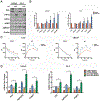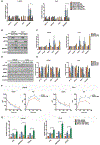Hypoxia-Reoxygenation Couples 3βHSD1 Enzyme and Cofactor Upregulation to Facilitate Androgen Biosynthesis and Hormone Therapy Resistance in Prostate Cancer
- PMID: 35536859
- PMCID: PMC9256813
- DOI: 10.1158/0008-5472.CAN-21-4256
Hypoxia-Reoxygenation Couples 3βHSD1 Enzyme and Cofactor Upregulation to Facilitate Androgen Biosynthesis and Hormone Therapy Resistance in Prostate Cancer
Abstract
Androgen deprivation therapy suppresses tumor androgen receptor (AR) signaling by depleting circulating testosterone and is a mainstay treatment for advanced prostate cancer. Despite initial treatment response, castration-resistant prostate cancer nearly always develops and remains driven primarily by the androgen axis. Here we investigated how changes in oxygenation affect androgen synthesis. In prostate cancer cells, chronic hypoxia coupled to reoxygenation resulted in efficient metabolism of androgen precursors to produce androgens and activate AR. Hypoxia induced 3βHSD1, the rate-limiting androgen synthesis regulator, and reoxygenation replenished necessary cofactors, suggesting that hypoxia and reoxygenation both facilitate potent androgen synthesis. The EGLN1/VHL/HIF2α pathway induced 3βHSD1 expression through direct binding of HIF2α to the 5' regulatory region of HSD3B1 to promote transcription. Overexpression of HIF2α facilitated prostate cancer progression, which largely depended on 3βHSD1. Inhibition of HIF2α with the small-molecule PT2399 prevented prostate cancer cell proliferation. These results thus identify HIF2α as a regulator of androgen synthesis and potential therapeutic target in prostate cancer.
Significance: Hypoxia followed by reoxygenation in prostate cancer drives androgen deprivation therapy resistance via increasing the rate-limiting enzyme and cofactors for androgen synthesis, revealing HIF2α as a therapeutic target to subvert resistance.
©2022 American Association for Cancer Research.
Conflict of interest statement
Conflict of interest
None of the authors have a conflict of interest associated with the work presented here.
Figures








Comment in
-
Uro-Science.J Urol. 2023 Apr;209(4):801-802. doi: 10.1097/JU.0000000000003161. Epub 2023 Jan 19. J Urol. 2023. PMID: 36655472 No abstract available.
Similar articles
-
Chronic hypoxia stabilizes 3βHSD1 via autophagy suppression.Cell Rep. 2024 Jan 23;43(1):113575. doi: 10.1016/j.celrep.2023.113575. Epub 2024 Jan 4. Cell Rep. 2024. PMID: 38181788 Free PMC article.
-
AR Signaling in Prostate Cancer Regulates a Feed-Forward Mechanism of Androgen Synthesis by Way of HSD3B1 Upregulation.Endocrinology. 2018 Aug 1;159(8):2884-2890. doi: 10.1210/en.2018-00283. Endocrinology. 2018. PMID: 29850791 Free PMC article.
-
Cancer-associated fibroblast-secreted glucosamine alters the androgen biosynthesis program in prostate cancer via HSD3B1 upregulation.J Clin Invest. 2023 Apr 3;133(7):e161913. doi: 10.1172/JCI161913. J Clin Invest. 2023. PMID: 37009898 Free PMC article.
-
Targeting the androgen receptor signaling pathway in advanced prostate cancer.Am J Health Syst Pharm. 2022 Jul 22;79(15):1224-1235. doi: 10.1093/ajhp/zxac105. Am J Health Syst Pharm. 2022. PMID: 35390118 Review.
-
Steroidogenesis in castration-resistant prostate cancer.Urol Oncol. 2023 May;41(5):240-251. doi: 10.1016/j.urolonc.2022.10.018. Epub 2022 Nov 11. Urol Oncol. 2023. PMID: 36376200 Review.
Cited by
-
Survival of men with metastatic hormone-sensitive prostate cancer and adrenal-permissive HSD3B1 inheritance.J Clin Invest. 2024 Sep 17;134(18):e183583. doi: 10.1172/JCI183583. J Clin Invest. 2024. PMID: 39286977 Free PMC article.
-
Chronic hypoxia stabilizes 3βHSD1 via autophagy suppression.Cell Rep. 2024 Jan 23;43(1):113575. doi: 10.1016/j.celrep.2023.113575. Epub 2024 Jan 4. Cell Rep. 2024. PMID: 38181788 Free PMC article.
-
HSD3B1 genotype and outcomes in metastatic hormone-sensitive prostate cancer with androgen deprivation therapy and enzalutamide: ARCHES.Cell Rep Med. 2024 Aug 20;5(8):101644. doi: 10.1016/j.xcrm.2024.101644. Cell Rep Med. 2024. PMID: 39168093 Free PMC article. Clinical Trial.
-
Targeting Prostate Cancer Metabolism Through Transcriptional and Epigenetic Modulation: A Multi-Target Approach to Therapeutic Innovation.Int J Mol Sci. 2025 Jun 23;26(13):6013. doi: 10.3390/ijms26136013. Int J Mol Sci. 2025. PMID: 40649790 Free PMC article. Review.
References
Publication types
MeSH terms
Substances
Grants and funding
LinkOut - more resources
Full Text Sources
Medical
Research Materials

